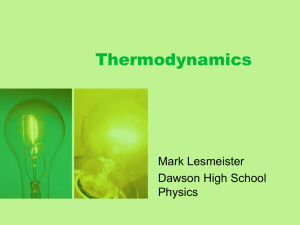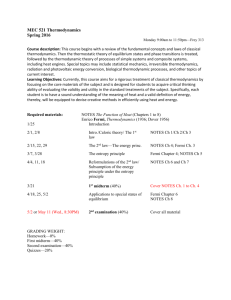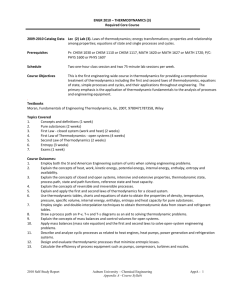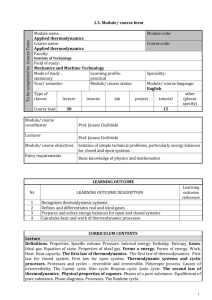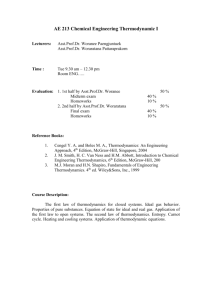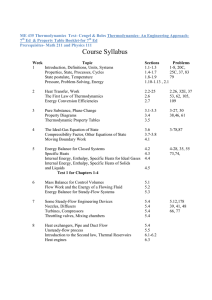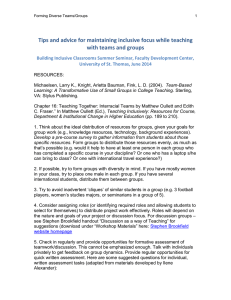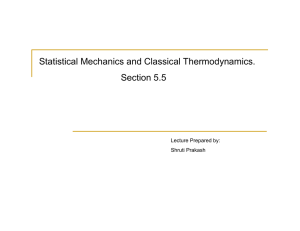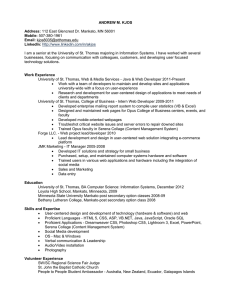Physics 225-01 - University of St. Thomas
advertisement
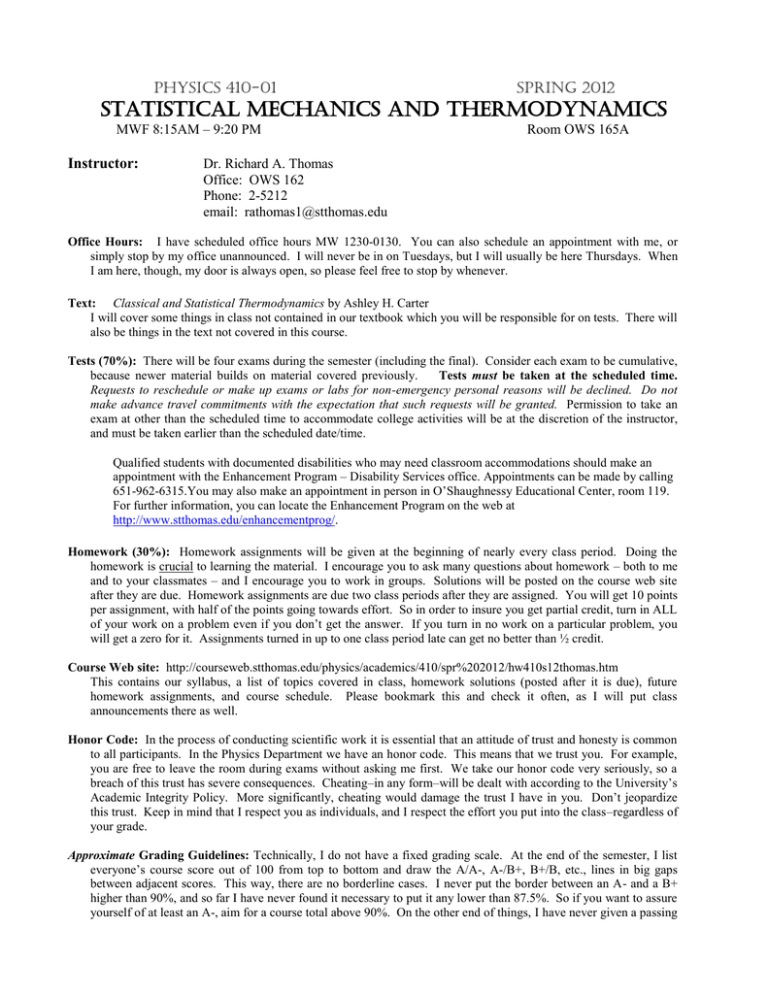
Physics 410-01 Spring 2012 Statistical Mechanics and Thermodynamics MWF 8:15AM – 9:20 PM Instructor: Room OWS 165A Dr. Richard A. Thomas Office: OWS 162 Phone: 2-5212 email: rathomas1@stthomas.edu Office Hours: I have scheduled office hours MW 1230-0130. You can also schedule an appointment with me, or simply stop by my office unannounced. I will never be in on Tuesdays, but I will usually be here Thursdays. When I am here, though, my door is always open, so please feel free to stop by whenever. Text: Classical and Statistical Thermodynamics by Ashley H. Carter I will cover some things in class not contained in our textbook which you will be responsible for on tests. There will also be things in the text not covered in this course. Tests (70%): There will be four exams during the semester (including the final). Consider each exam to be cumulative, because newer material builds on material covered previously. Tests must be taken at the scheduled time. Requests to reschedule or make up exams or labs for non-emergency personal reasons will be declined. Do not make advance travel commitments with the expectation that such requests will be granted. Permission to take an exam at other than the scheduled time to accommodate college activities will be at the discretion of the instructor, and must be taken earlier than the scheduled date/time. Qualified students with documented disabilities who may need classroom accommodations should make an appointment with the Enhancement Program – Disability Services office. Appointments can be made by calling 651-962-6315.You may also make an appointment in person in O’Shaughnessy Educational Center, room 119. For further information, you can locate the Enhancement Program on the web at http://www.stthomas.edu/enhancementprog/. Homework (30%): Homework assignments will be given at the beginning of nearly every class period. Doing the homework is crucial to learning the material. I encourage you to ask many questions about homework – both to me and to your classmates – and I encourage you to work in groups. Solutions will be posted on the course web site after they are due. Homework assignments are due two class periods after they are assigned. You will get 10 points per assignment, with half of the points going towards effort. So in order to insure you get partial credit, turn in ALL of your work on a problem even if you don’t get the answer. If you turn in no work on a particular problem, you will get a zero for it. Assignments turned in up to one class period late can get no better than ½ credit. Course Web site: http://courseweb.stthomas.edu/physics/academics/410/spr%202012/hw410s12thomas.htm This contains our syllabus, a list of topics covered in class, homework solutions (posted after it is due), future homework assignments, and course schedule. Please bookmark this and check it often, as I will put class announcements there as well. Honor Code: In the process of conducting scientific work it is essential that an attitude of trust and honesty is common to all participants. In the Physics Department we have an honor code. This means that we trust you. For example, you are free to leave the room during exams without asking me first. We take our honor code very seriously, so a breach of this trust has severe consequences. Cheating–in any form–will be dealt with according to the University’s Academic Integrity Policy. More significantly, cheating would damage the trust I have in you. Don’t jeopardize this trust. Keep in mind that I respect you as individuals, and I respect the effort you put into the class–regardless of your grade. Approximate Grading Guidelines: Technically, I do not have a fixed grading scale. At the end of the semester, I list everyone’s course score out of 100 from top to bottom and draw the A/A-, A-/B+, B+/B, etc., lines in big gaps between adjacent scores. This way, there are no borderline cases. I never put the border between an A- and a B+ higher than 90%, and so far I have never found it necessary to put it any lower than 87.5%. So if you want to assure yourself of at least an A-, aim for a course total above 90%. On the other end of things, I have never given a passing grade for a course point total less than 50% of the maximum. Midterm grades, however, are assigned according to a strict 90-100 = A, 80-90 = B, 70-80 = C, etc., scale. With each test you get back, you will be given two scores: one for that test, and one that indicates your current course score out of 100. Disclaimer: This syllabus and the following class schedule are subject to change as the semester progresses. TENTATIVE Course Schedule DATE JAN 30 1 3 6 8 10 13 FEB 15 17 20 22 24 27 29 2 5 7 9 12 14 MAR 16 19 21 23 26 28 30 2 4 6 9 11 13 APR 16 18 20 23 25 27 30 2 4 7 MAY 9 11 14 15 M W F M W F M W F M W F M W F M W F M W F M W F M W F M W F M W F M W F M W F M W F M W F M T CLASS TOPIC Course Intro Ch. 11: Kinetic Theory of Gases (skip section 11.2) Ch. 11: more kinetic theory--equipartition theorem, specific heat Ch. 11: derive Maxwell-Boltzmann distribution function, averages of v and v2 Ch. 11: mean free path, collision frequency, Ch. 3: first law, work for ideal gas processes Ch 1 (very quickly); Ch. 2: van der Waals eqn of state Ch 2: finish; Ch 3: expansion/compression of solids, exact vs. inexact differentials Ch 3: “configurational” vs. dissipative work; Ch 4: enthalpy Ch 4: Enthalpy; Ch 5: 1 st Law and Cycles EXAM #1 Ch 5: More on cycles Ch 6: 2 nd Law and Carnot cycle Ch 6: Entropy, etc. Ch 6: Clausius inequality, calculating ΔS Ch 6: more on calculating ΔS, formal definition of temperature Ch 7: TdS equations; Ch 8: begin thermodynamic potentials Ch 8: thermodynamic potentials Ch 8: thermodynamic potentials; Ch 9: chemical potential Ch 9: phase mixtures, mixtures of ideal gases EXAM 2????? Ch 10: The 3rd Law and Its Consequences Ch 12: macrostates vs. microstates, flipping coins, Stirling’s approximation NO CLASS – SPRING BREAK NO CLASS – SPRING BREAK NO CLASS – SPRING BREAK Ch 12: more on macrostates and entropy Ch 12: entropy, indistinguishable particles, degenerate states Ch 13: method of Lagrange multipliers, Boltzmann distribution. Ch 13: finish Lagrange multipliers, Boltzmann distribution Ch 12: density of states NO CLASS – EASTER BREAK NO CLASS – EASTER BREAK Ch 13: Fermi-Dirac and Bose-Einstein statistics Ch 13: more FD and BE stats, examples Ch 13: minor review, spin system example Ch 14: stat mech and the ideal gas Ch 15: the diatomic ideal gas EXAM #3??? Ch 16: phonons in solids, Einstein model Ch 16: phonons in solids, DeBye model Ch 17: intro to thermodynamics of magnetism Ch 17: more magnetism thermodynamics, some review The Ising model and criticality (not covered in book) TBA Ch 18: blackbody radiation Ch 19: Fermi gases Ch 19: Fermi gases, white dwarfs and neutron stars, course evals. NO CLASS study day before finals EXAM #4 (0800-1000 pm)
